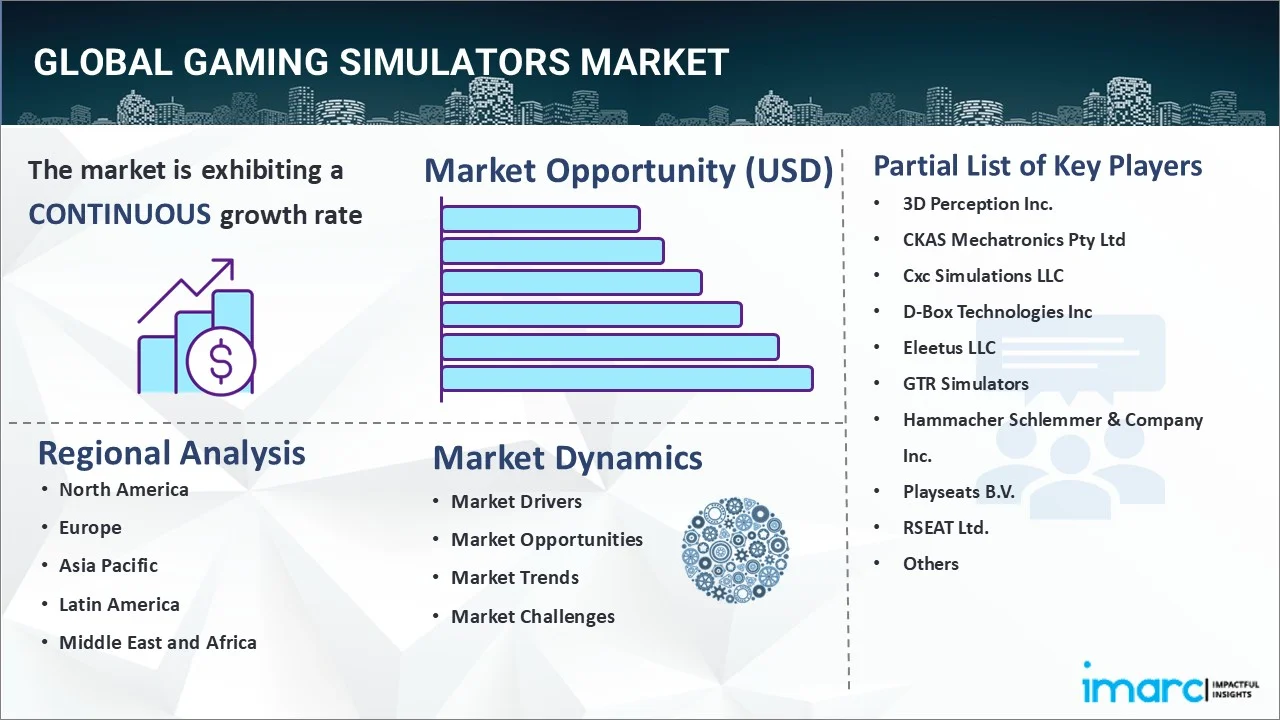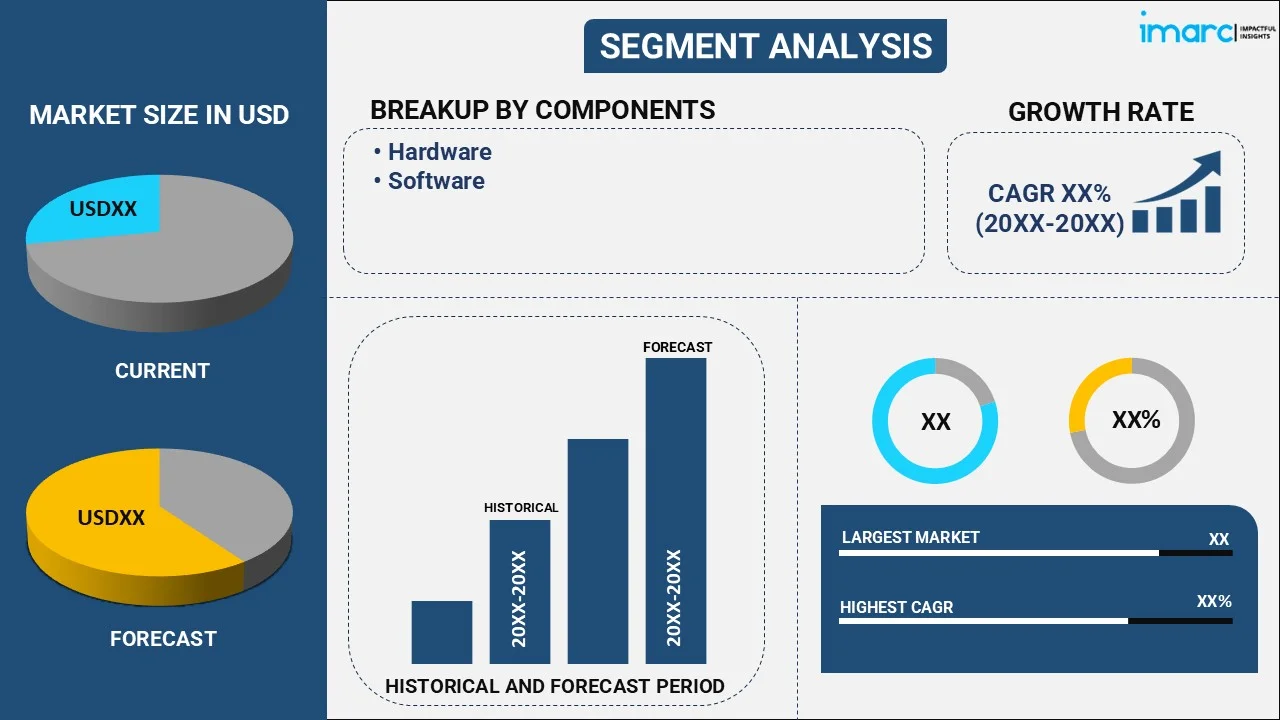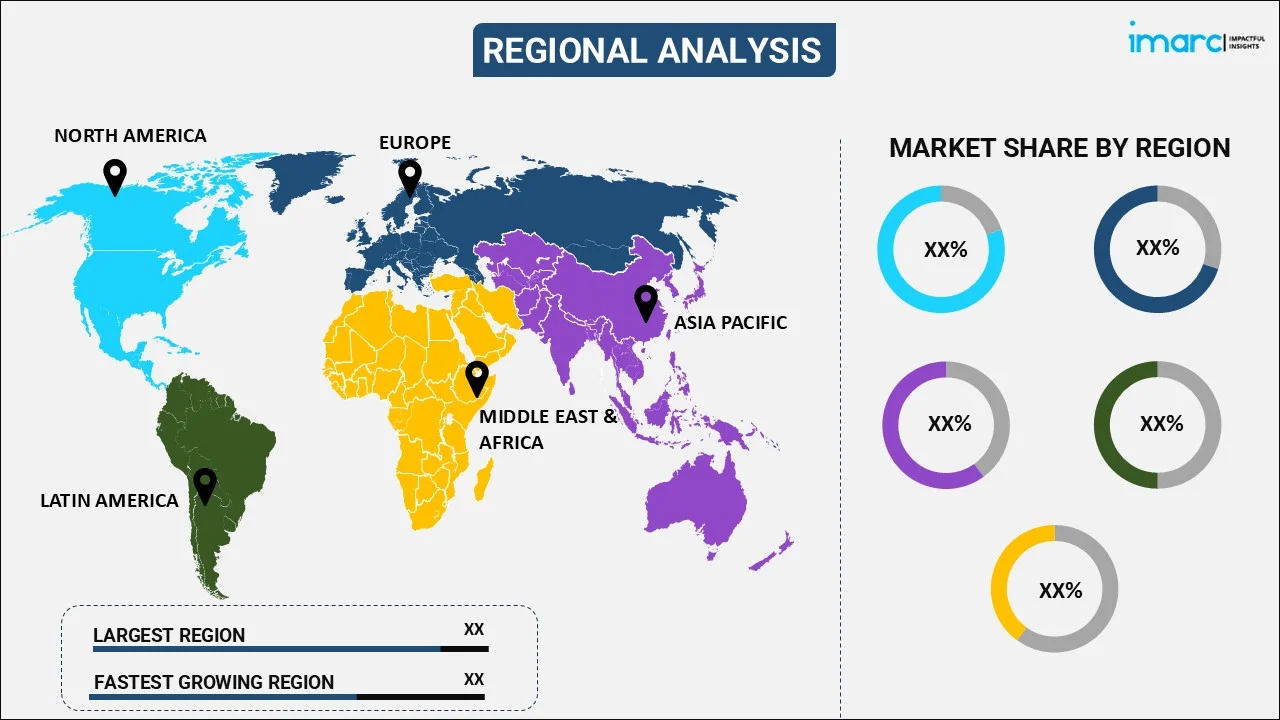
Gaming Simulators Market Report by Component (Hardware, Software), Game Type (Shooting, Fighting, Racing, and Others) End Use (Residential, Commercial), and Region 2025-2033
Gaming Simulators Market, 2024 Size & Trends:
The global gaming simulators market size reached USD 8.6 Billion in 2024. Looking forward, IMARC Group expects the market to reach USD 25.4 Billion by 2033, exhibiting a growth rate (CAGR) of 12.75% during 2025-2033. The surging popularity of esports and competitive gaming, technological advancements in virtual reality (VR) and augmented reality (AR), the pandemic-induced surge in at-home entertainment, rising disposable incomes, innovative partnerships between gaming companies and simulator manufacturers, and the integration of motion-sensing and haptic feedback technologies are factors boosting the market growth.
|
Report Attribute
|
Key Statistics
|
|---|---|
|
Base Year
|
2024
|
|
Forecast Years
|
2025-2033
|
|
Historical Years
|
2019-2024
|
|
Market Size in 2024
|
USD 8.6 Billion |
|
Market Forecast in 2033
|
USD 25.4 Billion |
| Market Growth Rate 2025-2033 | 12.75% |
Gaming Simulators Market Analysis:
- Market Growth and Size: The global gaming simulators market has been experiencing robust growth, primarily driven by the increasing popularity of esports and competitive gaming. It is a lucrative and expanding market, with a growing number of consumers seeking immersive gaming experiences.
- Major Market Drivers: The key drivers include the rise in esports, technological advancements such as VR and AR integration, the impact of the COVID-19 pandemic boosting at-home gaming, and the rising disposable income in emerging economies. Furthermore, the surge in online multiplayer gaming and esports events is supporting the market growth.
- Technological Advancements: Technological innovation, particularly in VR and AR, has significantly enhanced gaming simulators' realism and appeal, making them a vital component of the gaming industry.
- Industry Applications: Gaming simulators find applications in various gaming genres, including racing, first-person shooters, and sports simulations. Moreover, their adaptability to different gaming preferences and genres fuels their adoption.
- Key Market Trends: Notable trends include the integration of motion-sensing and haptic feedback technologies, which enhance the gaming experience. Additionally, artificial intelligence (AI) and machine learning (ML) features are becoming prominent, offering personalized and adaptive gameplay.
- Geographical Trends: Emerging economies, particularly in Asia, Latin America, and the Middle East, are witnessing a rising demand for gaming simulators due to increased disposable income. These regions represent significant growth opportunities.
- Competitive Landscape: North America boasts a substantial gaming community, that is significantly contributing to the demand for gaming simulators. Additionally, a growing number of esports tournaments and events in the region are facilitating the product demand.
- Challenges and Opportunities: Challenges include the need for continuous innovation to meet evolving gamer expectations and competition within the industry. Opportunities lie in expanding market reach, particularly in emerging economies, and developing cutting-edge simulator technologies to cater to diverse gaming needs.

Gaming Simulators Market Trends:
Increasing popularity of esports and competitive gaming
The rise in the popularity of esports and competitive gaming has emerged as a primary driver for the global gaming simulators market. Esports tournaments and competitive gaming events have garnered a massive following, with millions of viewers worldwide. As professional esports players and enthusiasts seek a more immersive gaming experience, the demand for advanced gaming simulators has surged. They offer a unique opportunity for players to train and compete in a controlled and highly realistic environment, mimicking the conditions of their respective games. This trend has driven simulator manufacturers to innovate, focusing on delivering top-notch equipment that can replicate the intricacies of esports titles.
Advancements in technology: VR and AR
Rapid advancements in technology, particularly in the realm of virtual reality (VR) and augmented reality (AR), have significantly contributed to the expansion of the gaming simulators market. VR and AR technologies have revolutionized how gamers interact with virtual worlds, enabling a more immersive and realistic gaming experience. Gaming simulators that incorporate VR and AR elements can transport players to fantastical realms, putting them at the center of the action. This level of immersion has attracted a broader audience, ranging from hardcore gamers to casual enthusiasts. The allure of stepping into a virtual world where the boundaries between reality and the game blur has led to increased adoption of these simulators. As these technologies continue to evolve, we can expect even more sophisticated and captivating gaming simulators to hit the market, further propelling the market growth.
Impact of the COVID-19 pandemic
The COVID-19 pandemic has had a profound impact on and the gaming simulators market owing to the surge in interest and sales of gaming simulators as people sought immersive and engaging experiences within the confines of their homes. With lockdowns and restrictions in place, people turned to indoor entertainment options, including gaming, which has further surged the demand for gaming content and accessories, including simulators, creating a significant opportunity for market growth. Gamers sought ways to enhance their at-home gaming experiences, and gaming simulators provided the ideal solution.
Rising disposable income
Another factor contributing to the expansion of the global gaming simulators market is the increasing disposable income of consumers. As economies in regions like Asia, Latin America, and the Middle East continue to grow, more individuals are gaining access to higher levels of disposable income. This has translated into a greater willingness to invest in leisure and entertainment, including gaming and gaming simulators. As a result, manufacturers have identified these emerging markets as lucrative opportunities and have been expanding their presence and distribution networks.
Gaming Simulators Industry Segmentation:
IMARC Group provides an analysis of the key trends in each segment of the market, along with forecasts at the global, regional, and country levels for 2025-2033. Our report has categorized the market based on component, game type, and end use.
Breakup by Component:

- Hardware
- Software
Hardware accounts for the majority of the market share
The report has provided a detailed breakup and analysis of the market based on the component. This includes hardware and software. According to the report, hardware represented the largest segment.
The hardware segment of the gaming simulators market is driven by the increasing demand for immersive and realistic gaming experiences. Players are seeking high-quality hardware components that can replicate the sensations of motion, force feedback, and environmental effects. Moreover, advancements in technology, such as precision sensors, high-resolution displays, and sophisticated motion actuators, are essential drivers in this segment. Additionally, the growth of esports and competitive gaming has spurred the need for specialized gaming hardware that can offer a competitive edge. As a result, hardware manufacturers are continually innovating to provide gamers with cutting-edge peripherals and simulators that enhance their gameplay immersion.
On the other hand, the software segment is driven by the increasing complexity and diversity of gaming content. As the gaming industry evolves, developers are creating more intricate and realistic gaming experiences, necessitating sophisticated software to support these advancements. Gaming simulators rely on specialized software to synchronize with hardware components and deliver lifelike scenarios.
Breakup by Game Type:
- Shooting
- Fighting
- Racing
- Others
Racing holds the largest share in the industry
A detailed breakup and analysis of the market based on the game type have also been provided in the report. This includes shooting, fighting, racing, and others. According to the report, racing accounted for the largest market share.
The racing segment is driven by the escalating demand for authentic driving experiences. Racing simulators cater to automotive enthusiasts and gamers alike, replicating the thrill of high-speed racing with realistic physics and controls. The immersive nature of racing simulators, especially when paired with VR technology, appeals to a broad audience, from professional racers looking to train to casual gamers seeking a thrilling experience on virtual tracks. Moreover, technological advancements in graphics, physics engines, and motion-sensing technologies have contributed to the appeal of racing simulators. Gamers can now enjoy stunningly detailed virtual tracks and vehicles, coupled with precise physics simulations that mimic the dynamics of real racing.
The shooting segment is driven by the increasing demand for realistic and immersive combat experiences in gaming. Advancements in graphics, sound, and controller technology allow players to engage in intense, lifelike battles, attracting both casual gamers and esports enthusiasts.
The fighting segment is driven by the growing popularity of competitive fighting games in the esports arena. Gamers seek to perfect their martial arts skills in highly detailed and responsive environments, making precision and timing paramount.
In the others segment, advancements in technology and a growing demand for specialized learning and entertainment experiences are driving the segment growth.
Breakup by End Use:
- Residential
- Commercial
Residential represents the leading market segment
The report has provided a detailed breakup and analysis of the market based on the end use. This includes residential and commercial. According to the report, residential represented the largest segment.
The residential segment is driven by the increasing demand for immersive home entertainment experiences. With the rise of esports and competitive gaming, enthusiasts are investing in gaming simulators to replicate the excitement of professional gaming within their homes. The affordability and accessibility of simulators have made them attractive to a wider consumer base, especially during the COVID-19 pandemic, where individuals sought ways to elevate their at-home entertainment. Additionally, the integration of VR and AR technologies into residential gaming simulators enhances the immersive experience, making them an appealing choice for those seeking a more realistic and engaging gameplay environment in the comfort of their homes.
On the other hand, the commercial segment is primarily propelled by the burgeoning esports industry and entertainment venues. Esports tournaments and gaming cafes have proliferated globally, driving the demand for high-quality gaming simulators. These venues require state-of-the-art equipment to cater to professional esports players and gaming enthusiasts alike. The competitive gaming scene's growth has led to substantial investments in commercial gaming simulators, providing a platform for training and hosting esports events.
Breakup by Region:

- North America
- United States
- Canada
- Europe
- Germany
- France
- United Kingdom
- Italy
- Spain
- Others
- Asia Pacific
- China
- Japan
- India
- South Korea
- Australia
- Indonesia
- Others
- Latin America
- Brazil
- Mexico
- Others
- Middle East and Africa
North America leads the market, accounting for the largest gaming simulators market share
The market research report has also provided a comprehensive analysis of all the major regional markets, which include North America (the United States and Canada); Europe (Germany, France, the United Kingdom, Italy, Spain, and others); Asia Pacific (China, Japan, India, South Korea, Australia, Indonesia, and others); Latin America (Brazil, Mexico, and others); and the Middle East and Africa. According to the report, North America accounted for the largest market share.
The North America region is driven by the increasing demand for gaming simulators, stemming from the flourishing esports industry, a large gaming community, and a higher disposable income. The region's well-established gaming culture has paved the way for gaming simulators to thrive, with a strong emphasis on realistic experiences and competitive gameplay. Technological advancements, including VR and AR integration, have further fueled the growth, making North America a prominent hub for gaming simulator development and adoption.
Europe’s gaming simulators market is driven by a combination of factors, including the growing interest in esports and competitive gaming, technological innovation, and a diverse gaming audience.
The Asia Pacific region is driven by the burgeoning gaming market, propelled by a vast population, increasing disposable income, and a strong esports presence. With a growing middle class, more individuals can afford gaming simulators, making the region a significant market. The adoption of advanced technologies like VR and AR is on the rise, providing a competitive edge to gaming simulator manufacturers.
Latin America’s gaming simulators market is driven by a combination of factors, including the rising popularity of esports, improved economic conditions, and an expanding gaming community. The region's interest in competitive gaming has boosted the demand for gaming simulators that offer a competitive edge.
The Middle East and Africa’s market is driven by the growing disposable income, an emerging gaming community, and the desire for high-quality gaming experiences. Technological advancements, especially in VR and AR, are attracting gamers looking for immersive gameplay.
Leading Key Players in the Gaming Simulators Industry:
Key players in the gaming simulators market are actively engaged in innovation and strategic partnerships to maintain their competitive edge. They are consistently investing in research and development (R&D) to enhance the realism and performance of their simulators. Many leading companies are integrating cutting-edge technologies such as virtual reality (VR), augmented reality (AR), motion-sensing, and haptic feedback to create more immersive and engaging gaming experiences. Additionally, partnerships with gaming studios and esports organizations are becoming increasingly common, allowing these companies to develop specialized simulators tailored to specific gaming genres and tournaments. Furthermore, efforts are being made to expand market reach by tapping into emerging economies in Asia, Latin America, and the Middle East, where disposable income and interest in gaming are on the rise.
The market research report has provided a comprehensive analysis of the competitive landscape. Detailed profiles of all major companies have also been provided. Some of the key players in the market include:
- 3D Perception Inc.
- CKAS Mechatronics Pty Ltd
- Cxc Simulations LLC
- D-Box Technologies Inc
- Eleetus LLC
- GTR Simulators
- Hammacher Schlemmer & Company Inc.
- Playseats B.V.
- RSEAT Ltd.
- Sony Interactive Entertainment Inc.
- Vesaro
(Please note that this is only a partial list of the key players, and the complete list is provided in the report.)
Latest News:
- March 15, 2023: 3D Perception Inc. made a significant leap in the gaming simulator industry with the launch of an immersive virtual reality (VR) simulator that seamlessly integrates motion simulation.
- April 28, 2023: CKAS Mechatronics Pty Ltd introduced a groundbreaking development by integrating artificial intelligence (AI) algorithms into their simulators. This AI-driven enhancement allows their simulators to adapt dynamically to user behavior in real-time.
- May 12, 2023: Cxc Simulations LLC introduced a cutting-edge force feedback system. This system meticulously replicates the subtle nuances of vehicle handling, elevating the realism of their simulators to new heights. Professional racing teams and simulation enthusiasts alike have praised this innovation for its precision and authenticity.
Gaming Simulators Market Report Scope:
| Report Features | Details |
|---|---|
| Base Year of the Analysis | 2024 |
| Historical Period | 2019-2024 |
| Forecast Period | 2025-2033 |
| Units | Billion USD |
| Segment Coverage | Exploration of Historical Trends and Market Outlook, Industry Catalysts and Challenges, Segment-Wise Historical and Future Market Assessment:
|
| Components Covered | Hardware, Software |
| Game Types Covered | Shooting, Fighting, Racing, Others |
| End Uses Covered | Residential, Commercial |
| Regions Covered | Asia Pacific, Europe, North America, Latin America, Middle East and Africa |
| Countries Covered | United States, Canada, Germany, France, United Kingdom, Italy, Spain, China, Japan, India, South Korea, Australia, Indonesia, Brazil, Mexico |
| Companies Covered | 3D Perception Inc., CKAS Mechatronics Pty Ltd, Cxc Simulations LLC, D-Box Technologies Inc, Eleetus LLC, GTR Simulators, Hammacher Schlemmer & Company Inc., Playseats B.V., RSEAT Ltd., Sony Interactive Entertainment Inc., Vesaro, etc. |
| Customization Scope | 10% Free Customization |
| Post-Sale Analyst Support | 10-12 Weeks |
| Delivery Format | PDF and Excel through Email (We can also provide the editable version of the report in PPT/Word format on special request) |
Key Questions Answered in This Report:
- How has the global gaming simulators market performed so far, and how will it perform in the coming years?
- What are the drivers, restraints, and opportunities in the global gaming simulators market?
- What is the impact of each driver, restraint, and opportunity on the global gaming simulators market?
- What are the key regional markets?
- Which countries represent the most attractive gaming simulators market?
- What is the breakup of the market based on the component?
- Which is the most attractive component in the gaming simulators market?
- What is the breakup of the market based on the game type?
- Which is the most attractive game type in the gaming simulators market?
- What is the breakup of the market based on the end use?
- Which is the most attractive end use in the gaming simulators market?
- What is the competitive structure of the market?
- Who are the key players/companies in the global gaming simulators market?
Key Benefits for Stakeholders:
- IMARC’s industry report offers a comprehensive quantitative analysis of various market segments, historical and current market trends, market forecasts, and dynamics of the gaming simulators market from 2019-2033.
- The research report provides the latest information on the market drivers, challenges, and opportunities in the global gaming simulators market.
- The study maps the leading, as well as the fastest-growing, regional markets. It further enables stakeholders to identify the key country-level markets within each region.
- Porter's five forces analysis assists stakeholders in assessing the impact of new entrants, competitive rivalry, supplier power, buyer power, and the threat of substitution. It helps stakeholders to analyze the level of competition within the gaming simulators industry and its attractiveness.
- The competitive landscape allows stakeholders to understand their competitive environment and provides insight into the current positions of key players in the market.
Need more help?
- Speak to our experienced analysts for insights on the current market scenarios.
- Include additional segments and countries to customize the report as per your requirement.
- Gain an unparalleled competitive advantage in your domain by understanding how to utilize the report and positively impacting your operations and revenue.
- For further assistance, please connect with our analysts.
 Request Customization
Request Customization
 Speak to an Analyst
Speak to an Analyst
 Request Brochure
Request Brochure
 Inquire Before Buying
Inquire Before Buying




.webp)




.webp)












